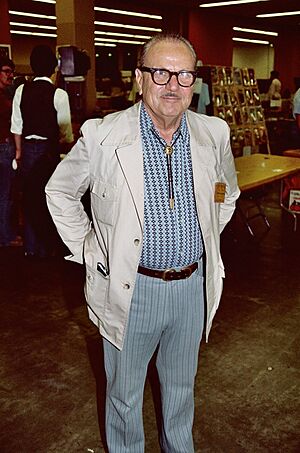Burne Hogarth facts for kids
Quick facts for kids Burne Hogarth |
|
|---|---|

Burne Hogarth at the 1982 San Diego Comic Con
|
|
| Born | Spinoza Bernard Ginsburg December 25, 1911 Chicago, Illinois, U.S. |
| Died | January 28, 1996 (aged 84) Paris, France |
| Area(s) | Artist, educator |
|
Notable works
|
Tarzan |
| Awards | Inkpot Award (1978) |
| burnehogarth.com | |
Burne Hogarth (born Spinoza Bernard Ginsburg, December 25, 1911 – January 28, 1996) was a famous American artist and teacher. He is best known for his amazing work on the Tarzan newspaper comic strip. He also wrote many popular books about drawing and human anatomy for other artists.
Contents
Early Life and First Comics
Burne Hogarth was born in Chicago in 1911. Even as a young boy, he showed a great talent for drawing. His father saved all his drawings. When Burne was just 12 years old, his father showed these drawings to the Art Institute of Chicago. Burne was accepted there and began his formal art education. He studied at several colleges, including Crane College and Northwestern University in Chicago. He also studied at Columbia University in New York City.
Burne's father passed away early, so Burne started working at age 15. He became an assistant at a company called Associated Editors Syndicate. There, he drew pictures for a series called Famous Churches of the World. He also worked as an editor and drew for advertisements. This work helped him earn money, which was very important during the Great Depression.
In 1929, he drew his first comic strip, Ivy Hemmanhaw. The next year, he drew Odd Occupations and Strange Accidents. As the Great Depression got worse, Burne moved to New York City. In 1934, he started working for King Features Syndicate. He drew a pirate adventure comic called Pieces of Eight.
Then, in 1936, he got a very important job. He was asked to draw the Tarzan comic strip. Burne Hogarth made the Tarzan comics very exciting and artistic. He drew the Tarzan "Sunday page" for 12 years, from 1937 to 1945, and again from 1947 to 1950. His Tarzan work has been printed many times since then.
Teaching Art to Others
Burne Hogarth was not just an artist; he was also a dedicated teacher. He taught drawing to many students over the years. By 1944, he wanted to open a school for soldiers returning from World War II. His first school was called the Manhattan Academy of Newspaper Art.
In 1947, he changed its name to the Cartoonists and Illustrators School. This school grew bigger and bigger. In 1956, it was renamed again to the School of Visual Arts (SVA). Today, SVA is one of the most famous art schools in the world! Burne Hogarth created the school's lessons. He also taught many classes, including drawing and art history.
Burne retired from SVA in 1970. But he kept teaching at other schools, like the Parsons School of Design. Later, he moved to Los Angeles and taught at the Otis School and Art Center College of Design.
Books for Artists
While he was teaching, Burne Hogarth wrote several important books. These books helped other artists learn about drawing. His first book, Dynamic Anatomy (1958), taught people how to draw the human body. He followed this with Drawing the Human Head (1965).
He wrote more books about drawing the human form. These included Dynamic Figure Drawing (1970) and Drawing Dynamic Hands (1977). He also wrote books about light and shadows, like Dynamic Light and Shade (1981). His last book, Dynamic Wrinkles and Drapery (1995), was about drawing clothes and folds.
Amazing Graphic Novels
After more than 20 years, Burne Hogarth returned to drawing comics in 1972. He created Tarzan of the Apes. This was a large, hardbound graphic novel, which is like a long comic book. It was published in 11 different languages!
He then made Jungle Tales of Tarzan in 1976. In this book, he used new and exciting art techniques. He used hidden images and clever color ideas to tell the story. These graphic novels, along with his comic strips, have inspired many artists around the world.
Burne Hogarth was also known for his lively speeches. He could talk about almost any topic, connecting different ideas in surprising ways. In his classes, he would ask students to think creatively. For example, he might say, "Paint me this sound: a spider walking on his web. What is the music of that sound?"
Awards and Legacy
Burne Hogarth received many awards for his work. In the United States, he won awards from the National Cartoonist Society. He also won dozens of awards from other countries. He continued to teach, write, and create art until his final days. He was often invited to big international art events.
In 1996, after attending a comics festival in France, he returned to Paris. He passed away there on January 28, at the age of 84.
In 2010, Burne Hogarth was honored by being added to the Will Eisner Award Hall of Fame. This is a special place for people who have made a big impact on comics.
See also
 In Spanish: Burne Hogarth para niños
In Spanish: Burne Hogarth para niños

